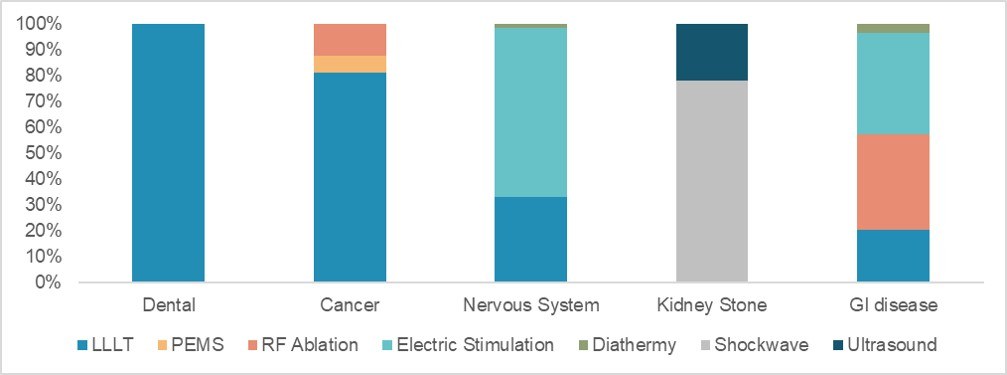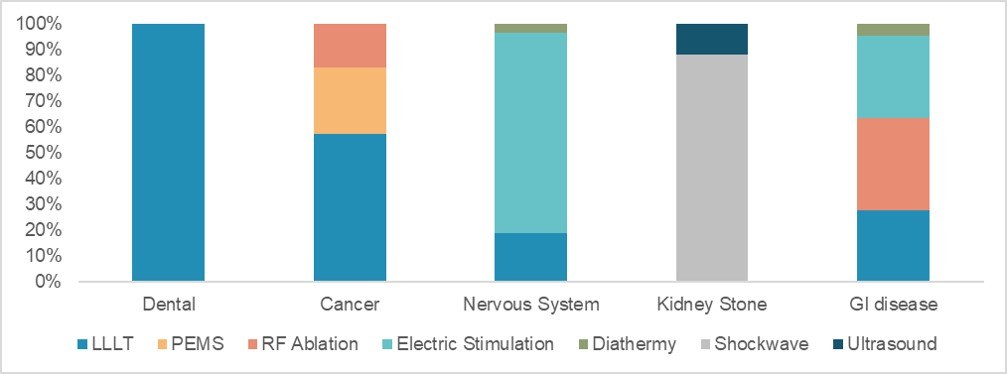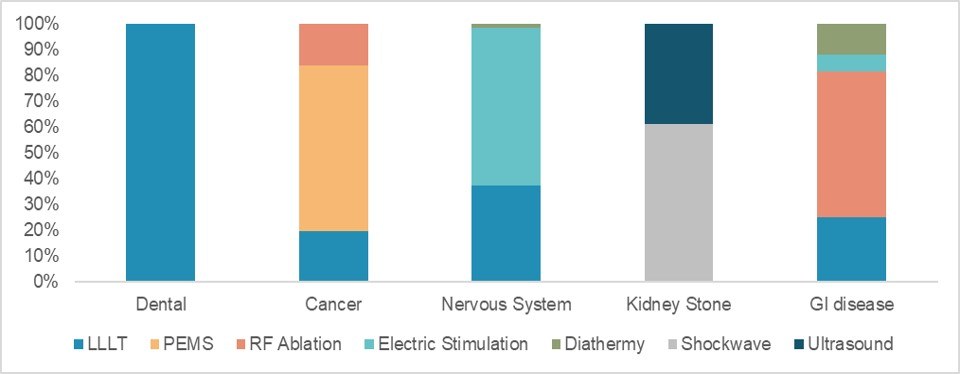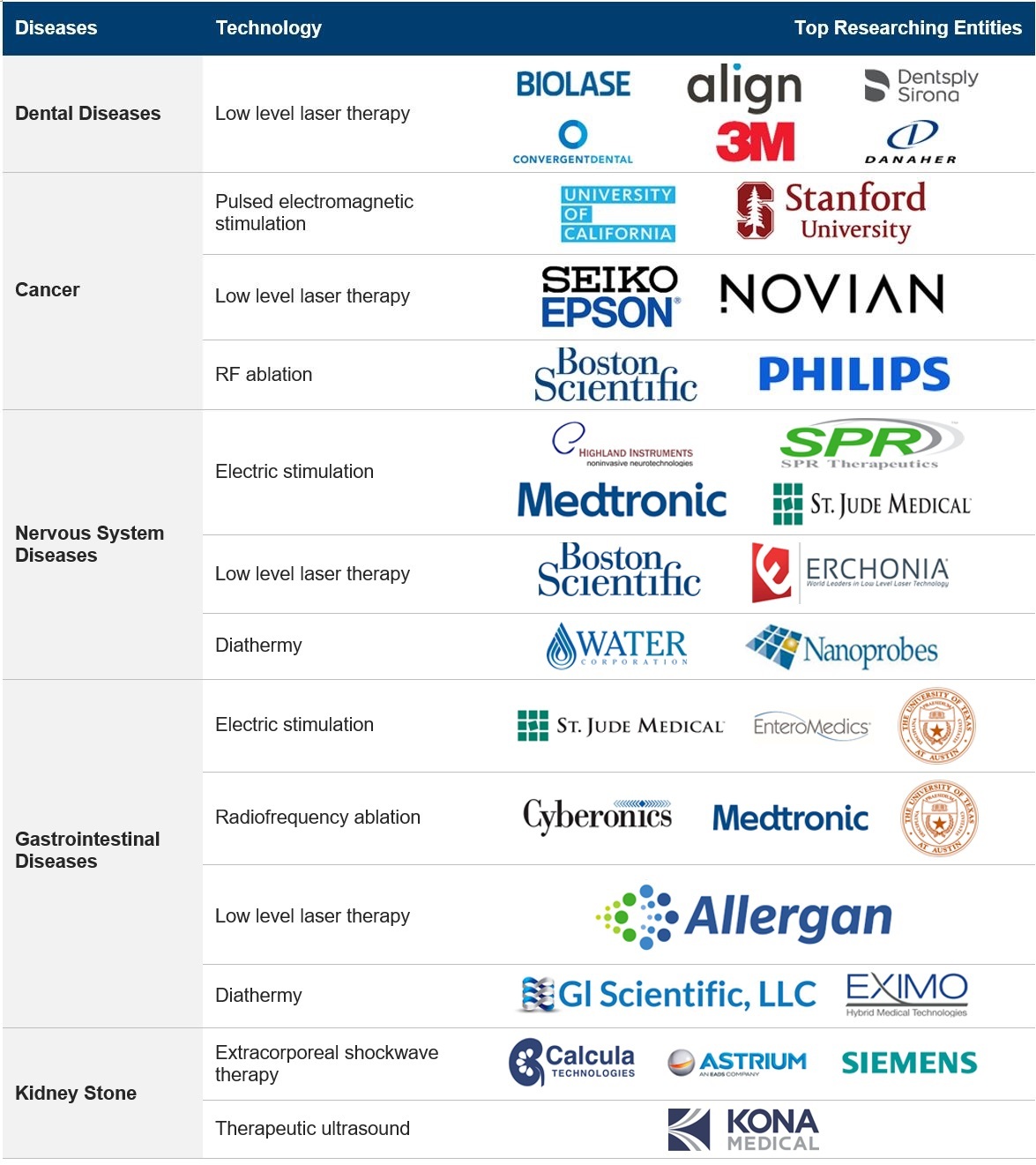Surge In Non-pharmacological Interventions For Treatment Of High-burden Diseases
Published on 27 Feb, 2020

Nonpharmacological treatment is gaining research interest and investment. It is noninvasive or minimally invasive, has few side-effects and is recognized by medical insurance companies. A few well-known therapies have been discussed in this article.
The number of people battling ailments, ranging from minor dental issues to chronic diseases, is increasing. Research and innovations are on in pharmacological approaches, surgery, and nonpharmacological interventions to discover effective treatments and remedies. Recent advancements in technology and side-effects associated with drugs have led to the increased research activity in nonpharmacological treatment methods.
Non-pharma treatment approaches, also referred to as alternate treatment, include use of technologies based on physical fundamental principles such as those related to heat, light, electricity, magnetism, pressure and mechanical waves. These technologies are noninvasive or minimally invasive and have fewer side-effects. Plus, clinical and economic efficiency is high. Most of these technologies are also covered under medical insurance and, therefore, highly preferred by clinicians and patients.
Some alternative treatment approaches are available for:
- Dental diseases: Caries, gingivitis, periodontitis, hypersensitivity, etc.
- Cancer: Skin cancer, prostate cancer, breast cancer, lung cancer, lymphoma, etc.
- Nervous system-related diseases: Affecting peripheral nerves such as peripheral neuropathy and peripheral nerve neuroma
- Kidney-related condition: Kidney stone
- Gastrointestinal tract diseases: Constipation, irritable bowel syndrome, hemorrhoids, anal fissures, perianal abscesses, anal fistulas, perianal infections, diverticular diseases, colitis, colon polyps, etc.
Table 1: Description of alternate treatment approaches covered in the study
|
Technology |
Description |
Major benefits |
|---|---|---|
|
Cryoablation |
This entails application of freezing temperatures (-90°C to -120°C) to achieve necrosis, which results from the freezing and thawing of cells. |
|
|
Shortwave Diathermy |
Diathermy, using high-frequency electromagnetic currents, induces heat, which improves local blood circulation to create a therapeutic effect. There are two types of diathermy:
|
|
|
Electric Stimulation |
It uses electric current (frequency of 1–100 Hz) to excite neuromuscular tissue and reduce the sensation of pain. |
|
|
Low Level Laser Therapy (LLLT) |
This entails the application of light from the visible spectrum (600–1000 nm), leading to increased ATP production, modulation of reactive oxygen species, and induction of transcription factors. |
|
|
Magnetic Therapy |
This entail the use of a permanent magnet to create a weak static magnetic field [between 300 and 5000 gauss (G)], which improves blood flow in underlying tissues. |
|
|
Pulsed Electromagnetic Stimulation (PEMS) |
Electromagnetic fields are applied to heal non-union fractures and depression. |
|
|
Pulsed Radiofrequency |
Pulsed or short bursts of radiofrequency current are used to dissipate heat and maintain temperature below 42°C. |
|
|
Radiofrequency Ablation |
Radio wave (350–500 kHz) is used to produce a current to heat up a small area of nerve tissue, thereby decreasing pain signals from that area. |
|
|
Extracorporeal Shockwave Therapy (ESWT) |
Shock wave is applied. It can:
|
|
|
Therapeutic Ultrasound |
Sound waves with frequencies in the range of 1–3 MHz are applied that heat deep tissues. |
|
Research activity matrix
Aranca has developed a matrix (refer Table 2) which highlights the research activity of these alternative treatment technologies across various diseases/health conditions. This matrix is based on factors such as IP filings, scientific literature publications, and clinical trials, which have been highlighted in Figures 1, 2 and 3, respectively.
Table 2: Technology Research Activity Matrix
|
Fundamental Principle |
Treatment Technologies |
Dental Disease |
Cancer |
Nervous System Disease |
Gastro-intestinal Diseases |
Kidney Stone |
|---|---|---|---|---|---|---|
Light |
LLLT |
|||||
Electric |
Stimulation |
|||||
Diathermy |
||||||
Mechanical Waves |
ESWT |
|||||
Therapeutic Ultrasound |
||||||
Electromagnetic energy |
Radiofrequency Ablation |
|||||
Pulsed Electromagnetic Stimulation |
||||||
Pulsed Radiofrequency |
||||||
Shortwave |
||||||
Thermal |
Cryoablation |
|||||
Magnet |
Magnetic Therapy |
Benchmarking Criteria:
High Research Activity: Highlighted in shades of Green
Medium Research Activity: Highlighted in shades of Yellow
Low Research Activity: Highlighted in shades of Red
Table 2 clearly indicates that LLLT and nerve stimulation are highly researched and versatile technologies. This could be due to the following reasons:
- Clinical: Can be applied in multiple diseases and have high clinical efficiency
- Ease of use: Are noninvasive or minimally invasive
- Socio-economic status: Are easily available and covered by insurance
Impact of alternative treatment technologies on diseases
Dental Diseases
LLLT seems to be a highly efficient therapy for the treatment of various dental diseases as it promotes tissue healing and reduces edema, inflammation, and pain. Also, it is used to sterilize root canal and manage bacteria-related dental conditions such as caries. This makes it a key target technology for manufacturers to expand in the dental domain.
Cancer
Several trials are being conducted using pulsed electromagnetic stimulation as it increases the survival rate of the patient by delaying the progression of the disease. LLLT is effective as it heals wounds due to the stimulation of cellular processes, such as proliferation, migration and differentiation. RF ablation technology is a targeted therapy in terms of destroying cancerous cells and preventing any damage to peripheral healthy cells. The new portable and affordable PEMF and LLLT devices are increasingly being researched for treatment of cancer. This shows that treatment could soon become an off-clinic procedure.
Nervous System Diseases
Nervous system diseases are difficult to diagnose and treat. The suggested therapies include electric stimulation, LLLT and diathermy that are used widely as they provide relief from symptomatic pain; increase the count of myelinated nerve fiber, thickness of myelin sheath, and axon diameter; and improve electrophysiological parameters, and locomotion. These technologies can be used in conjunction with conventional therapies for symptomatic treatment or to enhance the efficiency of other pharmacological therapies. Currently, wearable devices such as nerve stimulators are being explored, which indicates that portable and minimally invasive devices may become the preferred method of treatment in future. Therefore, entities working in this area would do well to focus on micro-level (wearable) technologies, considering the anticipated increase in demand.
Gastrointestinal Diseases
RF ablation and electric stimulation are assumed to be the most used technologies for the treatment GI-related diseases. RF ablation, LLLT and diathermy target the tissue, whereas electric stimulation targets the central, autonomic, enteric and/or other pathways to correct the conditions. The research in implantable nerve stimulating devices is picking up. These technologies may replace conventional therapies in near future.
Kidney Stone
Shockwave-focused ultrasound has been the most preferred noninvasive technology to treat kidney stones. However, devices that can break kidney stones, which are located deep in the body, without causing any pain to patients, are rare. Therefore, researchers can focus on high power shockwave that can break the deep-seated stones without inducing severe pain.
Figure 1: IP Filings

Figure 2: Scientific Literature

Figure 3: Clinical Trials

Top entities working on these technologies are listed in Table 3.
Table 3: Top Researching Entities

What can Aranca do for you?
Aranca can provide further assistance to help you understand overall technology trends, clinical effectiveness, and other opportunities in this domain. A sample table of contents covering the key research aspects is depicted below.
Table of Contents
- Currently available/under-development technologies
- Patent trends in terms of current state and technical advances in identified technologies
- Clinical research literature to benchmark efficiency of identified technologies in pain management
- Competitive landscape covering details on key players’ product offerings
